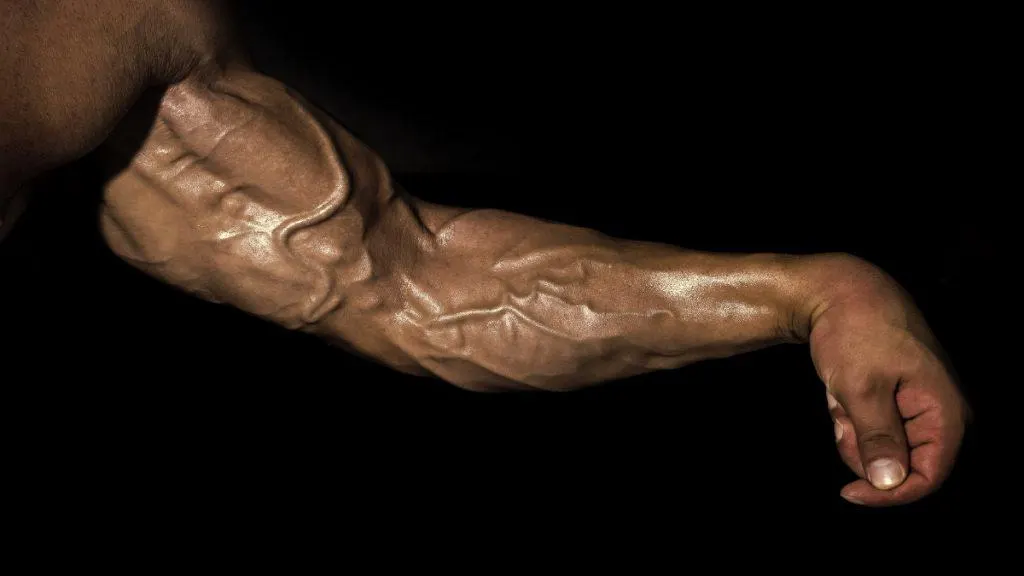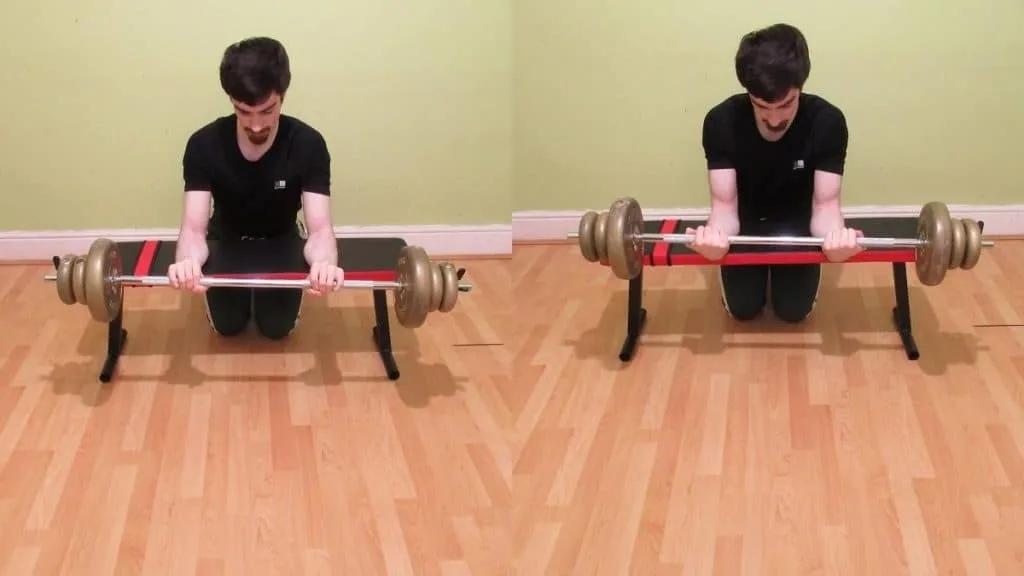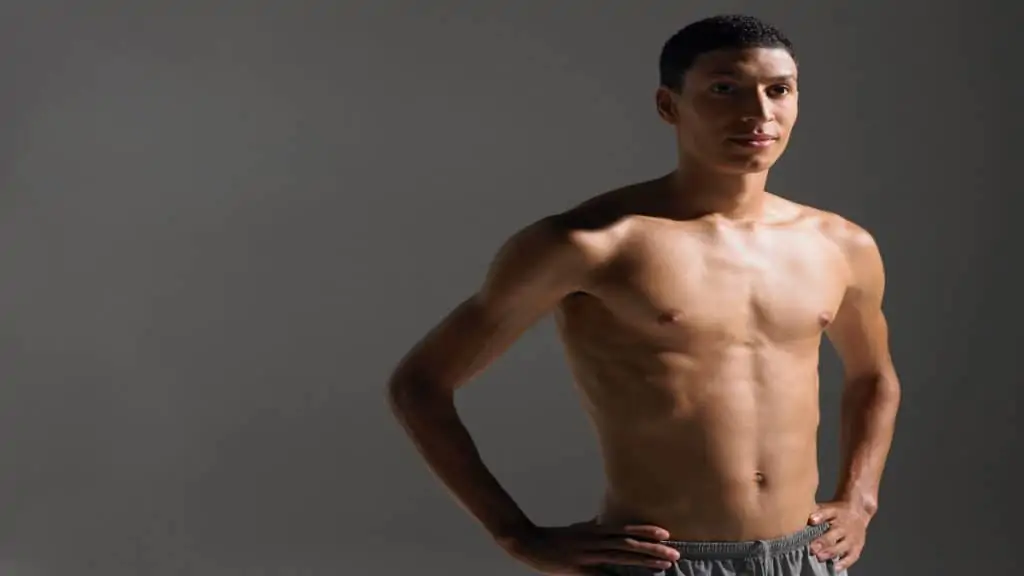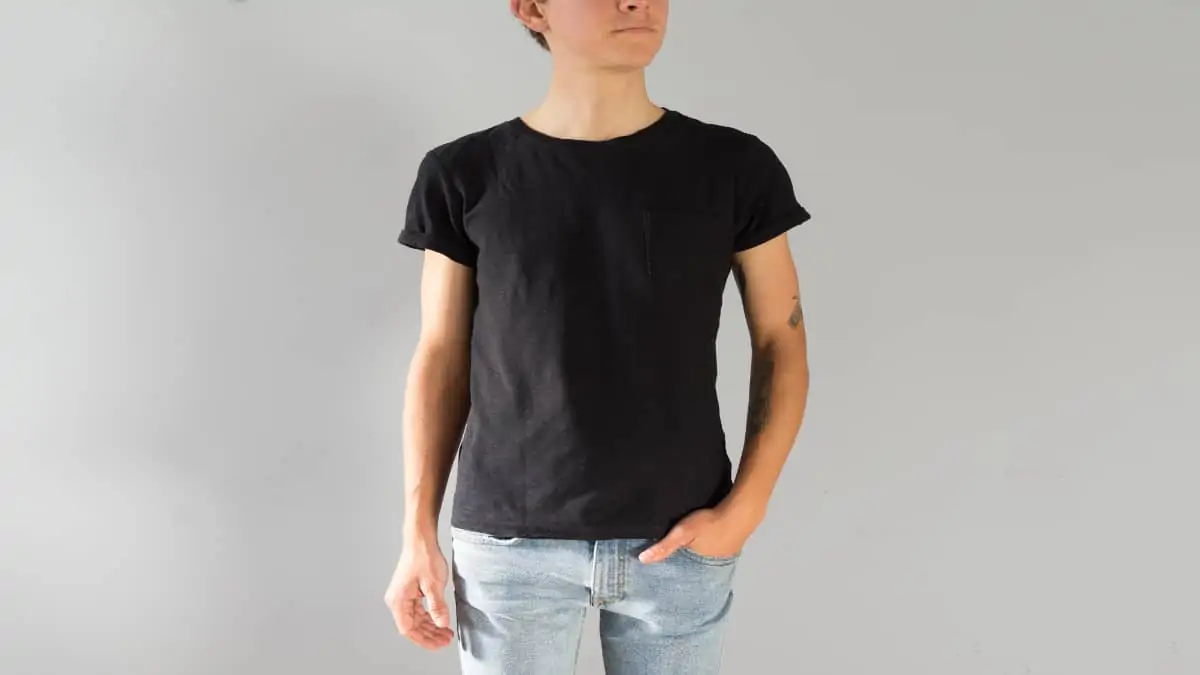The forearm is the most visible muscle group of the human body. As such, people often judge your muscularity based on the size and definition of your lower arms alone.
So when you have naturally skinny forearms, you can often feel self–conscious that people think you’re weak. And while most people are likely thinking about their own problems, I can understand why you’d want to grow your small forearms into big Popeye forearms.
This guide covers how to get bigger forearms if you naturally have thin lower arms due to your genetics or lack of resistance training.
If you currently have big biceps and small forearms, then this article will also help you gain the knowledge to build more symmetry into your physique.
Why are my forearms so skinny?

There are many reasons for someone having small forearm muscles.
First of all, if you’re a teenager, then it’s actually quite normal to have relatively thin forearms, and unless your doctor thinks that it’s a problem, it’s not something that you should worry about.
I had the same problem when I was younger, and as I gained muscle, it sorted itself out just fine.
Also, it’s possible that your skinny forearms are due to your genetics. If you’re somewhat tall or simply have less overall muscle, then your body mass will naturally be distributed over a larger surface area, which can result in your lower arms looking a little thin.
More realistically, perhaps you just aren’t performing weight training for them?
But even if you are doing regular resistance training, don’t worry if you still have thin forearms because, as a small muscle group, the lower arms can take a while to fill out. Plus, muscle doesn’t just grow overnight. It can take months to see the results from your work in the gym.
You can also read our forearm hypertrophy guide for more mass gaining tips.
Another reason for having a skinny forearm could be insufficient calories. New muscle will only grow if you consume enough high-quality protein and healthy calories to support extra body mass.
How to get rid of your skinny forearms
Why are my forearms so small? We often hear people say this. But if you’re serious about gaining muscle, then you need to put your knowledge into practice so that you can enjoy the gains.
Perform direct training

Some people train their lower arms so much that they almost have bigger forearms than biceps. And while this is an unlikely occurrence for most of us, it just shows the power of direct training.
I class direct training as any exercise in which the forearms are the first to fatigue and give out, i.e., where they’re the prime movers. Wrist curls are the obvious example, but I also like doing grip training drills (such as farmer’s walks) for building overall mass.
Increase your calorie intake

Muscle growth, at least in the initial stage when you have lots of it to build, can often happen faster when you eat in a calorie surplus because your body has extra energy in the form of calories that it can use to create new muscle tissue. [1]
Eating in a calorie surplus is easy. While many people track their calories, this behavior is quite unnatural and can quickly take the enjoyment out of eating. Plus, some of those apps and tracking methods are inherently inaccurate.
Anyway, I recommend adding another high-protein meal into your daily routine and/or having slightly larger portions for your everyday meals.
Doing this should help you gain weight, and over time, this new body mass will slowly get rid of your small forearm muscles.
Read more: best forearms in bodybuilding
Get good recovery

Recovery involves eating enough protein and calories, getting enough sleep, and performing a sensible amount of training volume in the gym. [2]
Remember that your lower arms get worked during virtually every pulling exercise. Therefore, you can achieve great gains from just a few hard sets of forearm curls.
Oftentimes people are impatient, and so they think that doing twice as many sets as they need to will earn them faster results. This might be the case initially, but once you get those novice gains, muscle growth slows down significantly.
As such, do a modest amount of sets so that you can recover properly and still perform your regular resistance training in addition to your forearm work.
Train all parts of the forearm

Even a skinny forearm with good definition can show you the key muscles. [3] On the underside of your lower arm, there are the flexors; on the top, you have the extensors; then further up near your biceps, there’s the brachioradialis.
You can train the flexors and extensors with grip work and wrist curls.
As for the brachioradialis, hammer curls and reverse curls are your best bet.
Many people just work the flexors and call it a day. But by bucking the trend and training all of the muscles, your lower arms will look more impressive from every angle, and you’ll be well on your way to achieving a great forearms before and after transformation.
Plus, by going the extra mile and training all the muscles, you certainly won’t have thin forearms anymore, that’s for sure.
How long will it take to get rid of small forearms?

This depends on your starting point and current level of training advancement, which is to say, how close you are to your genetic forearm potential.
If you still have a lot of muscle to gain, then you can cure your skinny forearms quite quickly. You can actually see good results in just 6-10 weeks with the right diet and training regime.
Also note, that the status of a muscle group (whether it’s novice, intermediate, advanced, etc.) is determined on a muscle by muscle basis.
So if you have a good overall physique and lagging forearms, then you can still see relatively fast results from direct training.
But if you have naturally weak forearms and wrists due to your genetics, then it might take a bit longer than normal to gain muscle.
As you’ll see around the internet, though, many people with so-called “bad genetics” have gained plenty of muscle naturally.
What’s a good workout for thin forearms?

If you currently have small forearm muscles, this workout will help because it works all the main muscle groups of the lower arms.
I recommend just doing it once per week because all of the other pulling exercises that you do already add up to quite a lot of training volume for the forearms.
Eventually, though, once you’ve milked the initial growth, you can experiment with training your forearms twice a week or more to try and squeeze out some extra gains. [4]
1: Wrist curl — 3 x 10-12 reps
2: Reverse wrist curl — 3 x 15-20 reps
3: Reverse curl — 3 x 8-12 reps
4: Farmer’s carry — 3 x 30 second holds
Read more: blood flow restriction training for forearms
Conclusion: Bulking up your skinny forearms

Bulking up your skinny forearms is a relatively straightforward task if you have the dedication and patience.
Essentially, don’t go changing your diet and training regime every few weeks if you don’t see immediate progress.
Muscle growth takes time to manifest, but the long-term results are always worth the initial waiting period.
And remember, small forearms can benefit from even a modest size gain because the lower arms are naturally small in circumference compared to other body parts. Good luck on your quest to gaining muscle!
References
- Slater, G. J., Dieter, B. P., Marsh, D. J., Helms, E. R., Shaw, G., & Iraki, J. (2019). Is an Energy Surplus Required to Maximize Skeletal Muscle Hypertrophy Associated With Resistance Training. Frontiers in Nutrition, 6. https://doi.org/10.3389/fnut.2019.00131
- Chen, Y., Cui, Y., Chen, S., & Wu, Z. (2017). Relationship between sleep and muscle strength among Chinese university students: a cross-sectional study. Journal of Musculoskeletal and Neuronal Interactions, 17(4), 327–333. https://www.ncbi.nlm.nih.gov/pmc/articles/PMC5749041/
- Wu, L., Goto, Y., Taniwaki, T., Kinukawa, N., & Tobimatsu, S. (2002). Different patterns of excitation and inhibition of the small hand and forearm muscles from magnetic brain stimulation in humans. Clinical Neurophysiology, 113(8), 1286–1294. https://doi.org/10.1016/s1388-2457(02)00160-8
- Grgic, J., Schoenfeld, B. J., Davies, T. B., Lazinica, B., Krieger, J. W., & Pedisic, Z. (2018). Effect of Resistance Training Frequency on Gains in Muscular Strength: A Systematic Review and Meta-Analysis. Sports Medicine, 48(5), 1207–1220. https://doi.org/10.1007/s40279-018-0872-x

